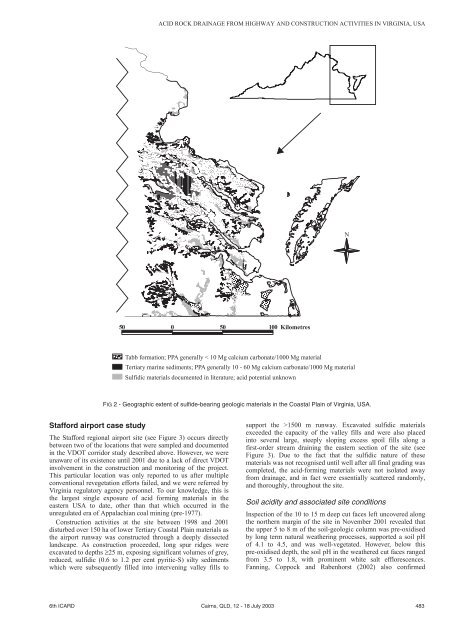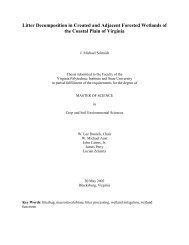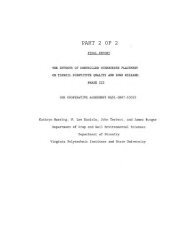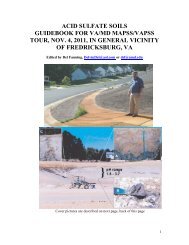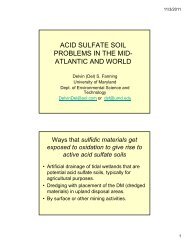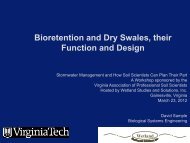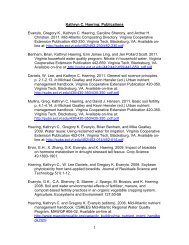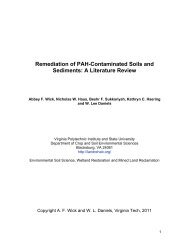Daniels and Orndorff, 2003 ICARD Acid Rock Drainage
Daniels and Orndorff, 2003 ICARD Acid Rock Drainage
Daniels and Orndorff, 2003 ICARD Acid Rock Drainage
Create successful ePaper yourself
Turn your PDF publications into a flip-book with our unique Google optimized e-Paper software.
Stafford airport case study<br />
The Stafford regional airport site (see Figure 3) occurs directly<br />
between two of the locations that were sampled <strong>and</strong> documented<br />
in the VDOT corridor study described above. However, we were<br />
unaware of its existence until 2001 due to a lack of direct VDOT<br />
involvement in the construction <strong>and</strong> monitoring of the project.<br />
This particular location was only reported to us after multiple<br />
conventional revegetation efforts failed, <strong>and</strong> we were referred by<br />
Virginia regulatory agency personnel. To our knowledge, this is<br />
the largest single exposure of acid forming materials in the<br />
eastern USA to date, other than that which occurred in the<br />
unregulated era of Appalachian coal mining (pre-1977).<br />
Construction activities at the site between 1998 <strong>and</strong> 2001<br />
disturbed over 150 ha of lower Tertiary Coastal Plain materials as<br />
the airport runway was constructed through a deeply dissected<br />
l<strong>and</strong>scape. As construction proceeded, long spur ridges were<br />
excavated to depths ≥25 m, exposing significant volumes of grey,<br />
reduced, sulfidic (0.6 to 1.2 per cent pyritic-S) silty sediments<br />
which were subsequently filled into intervening valley fills to<br />
ACID ROCK DRAINAGE FROM HIGHWAY AND CONSTRUCTION ACTIVITIES IN VIRGINIA, USA<br />
FIG 2 - Geographic extent of sulfide-bearing geologic materials in the Coastal Plain of Virginia, USA.<br />
support the >1500 m runway. Excavated sulfidic materials<br />
exceeded the capacity of the valley fills <strong>and</strong> were also placed<br />
into several large, steeply sloping excess spoil fills along a<br />
first-order stream draining the eastern section of the site (see<br />
Figure 3). Due to the fact that the sulfidic nature of these<br />
materials was not recognised until well after all final grading was<br />
completed, the acid-forming materials were not isolated away<br />
from drainage, <strong>and</strong> in fact were essentially scattered r<strong>and</strong>omly,<br />
<strong>and</strong> thoroughly, throughout the site.<br />
Soil acidity <strong>and</strong> associated site conditions<br />
Inspection of the 10 to 15 m deep cut faces left uncovered along<br />
the northern margin of the site in November 2001 revealed that<br />
the upper 5 to 8 m of the soil-geologic column was pre-oxidised<br />
by long term natural weathering processes, supported a soil pH<br />
of 4.1 to 4.5, <strong>and</strong> was well-vegetated. However, below this<br />
pre-oxidised depth, the soil pH in the weathered cut faces ranged<br />
from 3.5 to 1.8, with prominent white salt efflorescences.<br />
Fanning, Coppock <strong>and</strong> Rabenhorst (2002) also confirmed<br />
6th <strong>ICARD</strong> Cairns, QLD, 12 - 18 July <strong>2003</strong> 483


